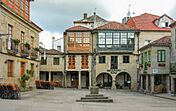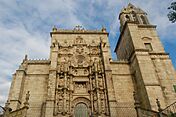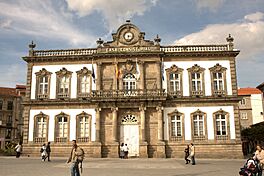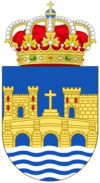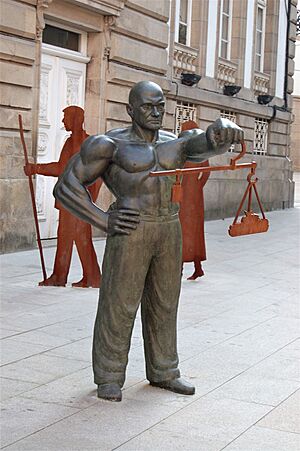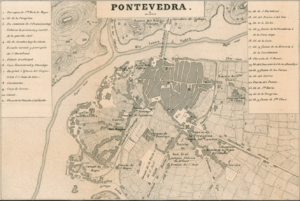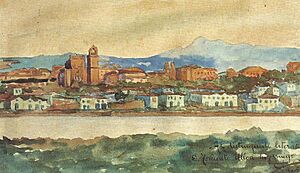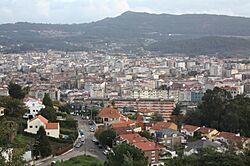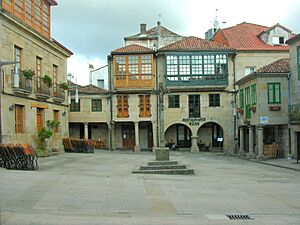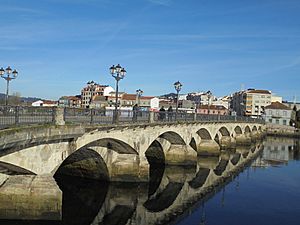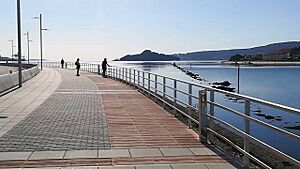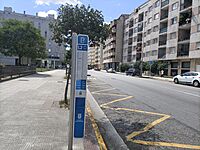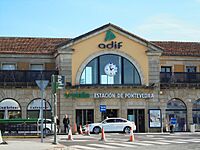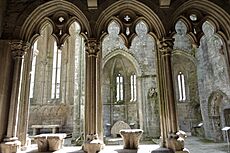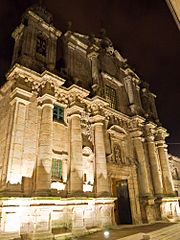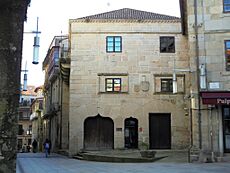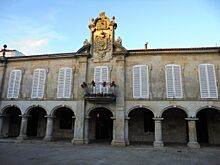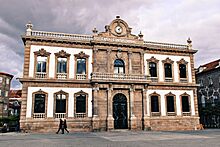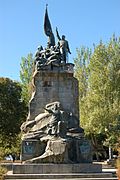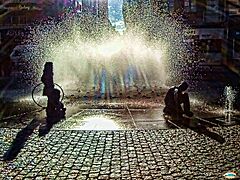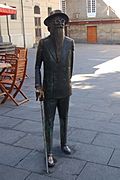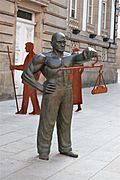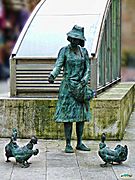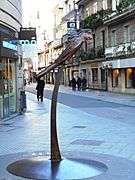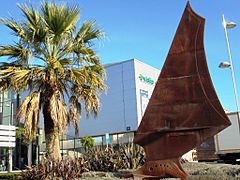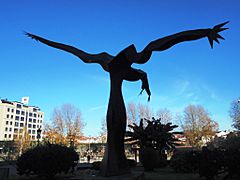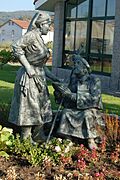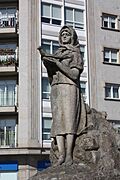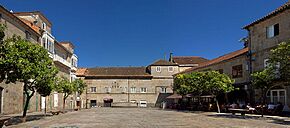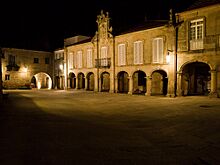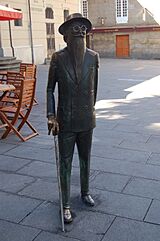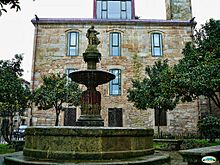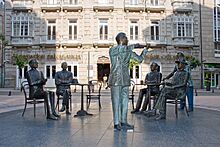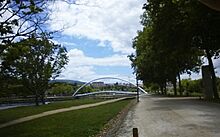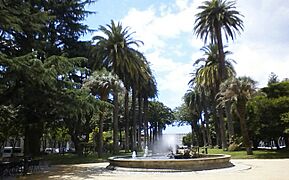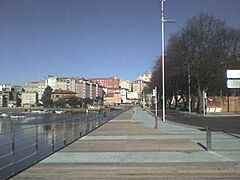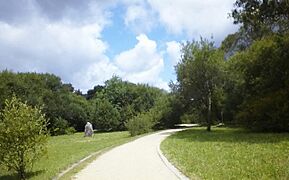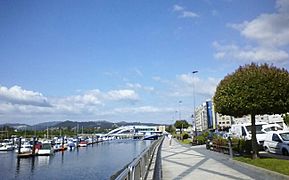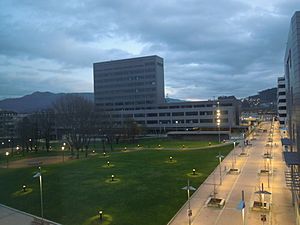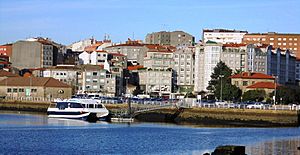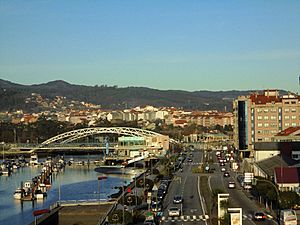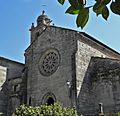Pontevedra facts for kids
Quick facts for kids
Pontevedra
|
|||
|---|---|---|---|
|
Plaza de la Leña
City Hall
|
|||
|
|||
| Motto(s):
Pontevedra boa vila (The good city of Pontevedra)
|
|||
| Country | |||
| Region | |||
| Province | Pontevedra | ||
| Comarca | Pontevedra | ||
| Parishes | Alba, Bora, O Burgo, Campañó, Campolongo, A Canicouva, Cerponzóns, Lérez, Lourizán, Marcón, Monteporreiro, Mourente, Ponte Sampaio, San Bartolomé de Pontevedra, Santa María de Pontevedra, A Virxe do Camiño de Pontevedra, Salcedo, Santa María de Xeve, Tomeza, Verducido, Xeve | ||
| Government | |||
| • Type | Ayuntamiento | ||
| • Body | City Council of Pontevedra | ||
| Area | |||
| • Total | 118.3 km2 (45.68 sq mi) | ||
| Elevation | 20 m (70 ft) | ||
| Population
(2018)
|
|||
| • Total | 82,802 | ||
| • Density | 701.0/km2 (1,815.5/sq mi) | ||
| Demonym(s) | pontevedrés (m), pontevedresa (f) lerense teucrino (m) teucrina (f) |
||
| Time zone | CET (GMT +1) | ||
| • Summer (DST) | CEST (GMT +2) | ||
| Postcode |
36001-36164
|
||
| Area code(s) | +34 986 / 886 | ||
| ISO 3166-2 | ES-PO | ||
| Website | City of Pontevedra | ||
Pontevedra is a beautiful city in northwestern Spain. It is the capital of the Province of Pontevedra and the Rías Baixas region. The city is famous for its smart urban planning and for being very walkable. Its charming old town is a favorite for visitors.
Pontevedra has won many awards for its city design. These include the European Intermodes Urban Mobility Award in 2013 and the Dubai International Best Practices Award in 2014. It also received an Excellence Award from the Center for Active Design in New York City in 2015. In 2020, the European Commission gave it a top prize for urban safety.
The city is surrounded by hills and sits by the sea, where the Lérez river meets the Ria de Pontevedra. It's a busy place for business and a popular spot for tourists. In 2020, about 83,260 people lived here. Pontevedra is also the center of a larger area with over 200,000 people.
Pontevedra has the second most important historic center in Galicia, after Santiago de Compostela. It's known as The Good City or The City of the Lérez. It's also an important stop for pilgrims on the Camino de Santiago. The unique Church of the Pilgrim Virgin was built for these travelers in the 18th century.
The city's old town has many beautiful squares and old religious buildings. These include the Basilica of Saint Mary Major (from the 16th century) and the Church of the Pilgrim Virgin (18th century). You can also see the ruins of the Gothic Convent of San Domingo and the Church of San Francisco. Many old noble houses with coat of arms and grand mansions also fill the city. A fun symbol of the city is the Ravachol Parrot statue. Pontevedra is known as The City of Children because it's a great place for kids to live.
Pontevedra is a key center for government, law, military, history, and culture. In the 16th century, it was the largest city in Galicia. Today, it has many government offices, courts, and cultural places like the Pontevedra Museum and the Pontevedra Auditorium and Convention Centre.
Contents
History of Pontevedra
What is the origin of Pontevedra's name?
The name Pontevedra likely comes from Latin words meaning "old bridge." This refers to an old Roman bridge over the Lérez River. This bridge was near the Burgo Bridge, which is still there today. Some historians also think the name might mean "green sea," because of the green seaweed in the water.
How old is Pontevedra?
Local stories say the city was founded by Teucer, a hero from the Trojan War. But historians and archaeologists believe the city started when Gallaecia (old Galicia) became part of the Roman Empire around the 1st century BC. Pontevedra grew into an important town during the Suebic period (around 5th–6th century AD).
What was Pontevedra like in the Middle Ages?
Pontevedra became a major trading center in the 12th century. It was most important in the 15th century as a hub for trade and communication. It had the second largest "old town" in Galicia, after Santiago de Compostela. The city was also a stop on the the Portuguese Way path of the Way of Saint James. The Church of the Pilgrim Virgin was built for pilgrims.
In the 16th century, Pontevedra was still a busy fishing and trading city. It was the largest port in Galicia because it was safe and open to the sea. One of Christopher Columbus's ships, the Santa Maria, was even built here. Over time, the Lérez river brought too much sediment, making the harbor too shallow for large ships. This led to the city's decline by the end of the 16th century.
How did Pontevedra change in recent centuries?
The city's situation got worse in the 17th and 18th centuries. The port became less active, and political problems caused trade to drop. Many people left the city, and diseases also reduced the population.
In the early 1800s, fishing and crafts helped the economy. In 1833, Pontevedra became a provincial capital, which helped it grow. It became an important center for government, culture, and business. The railway also reconnected the city to the rest of Spain. This period brought a cultural and economic rebirth. In 1853, the first book in modern Galician was published in Pontevedra.
What happened in Pontevedra in the 20th century?
Pontevedra started the 20th century with high hopes. It was a key place for Galician culture and politics. Important Galician thinkers lived here and founded the Galicianist Party in 1931. However, the Spanish Civil War (1936–1939) and the Francoist dictatorship (1939–1975) stopped this progress. Many people had to leave due to political problems and economic hardship.
During the 1940s–1960s, the government helped the nearby city of Vigo grow economically. This was at the expense of Pontevedra. The city's economy only began to recover in the 1960s with some new industries. But these industries later caused environmental problems, leading to some closures.
After the dictatorship ended in 1975, the construction industry grew. Better roads and transport in the 1980s and 1990s helped Pontevedra become important again. It focused on its role as a provincial capital and trade center. University studies started in the 1990s, helping the city grow even more. Since 1999, Pontevedra has seen a big renewal, with many improvements to the city and its culture.
How has Pontevedra changed in the 21st century?
In the 21st century, Pontevedra has had a cultural rebirth and a major urban change. The city center became pedestrian-only, and more bike lanes were added. Old buildings and public spaces were fixed up, and more green areas were created. Unlike other big cities in Galicia, Pontevedra's population is growing. It has become one of the most accessible cities for people with disabilities.
Pontevedra has won many awards for its urban model. These include the European INTERMODES Urban Mobility Award in 2013 and the Dubai International Best Practices Award in 2014. The city's way of managing traffic is now a global example.
Geography of Pontevedra
Where is Pontevedra located?
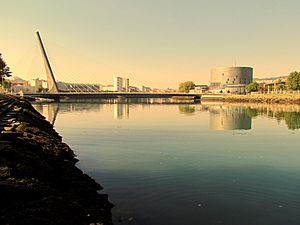
The city of Pontevedra is in southwestern Galicia, a region known as Rias Baixas. The city covers about 118.3 square kilometers. It sits at the end of the ria (a river valley flooded by the sea). The Lérez and Tomeza rivers flow through it. The city is surrounded by hills.
Pontevedra borders several other towns. To the north are Barro, Moraña, and Campo Lameiro. To the east are Cotobade and Ponte Caldelas. To the south are Soutomaior, Vilaboa, and Marín. To the west are Poio and the ria, which leads to the Atlantic Ocean.
The main areas of Pontevedra include the old town, the city center, O Burgo, Campolongo, and Monte Porreiro.
What is Pontevedra's climate like?
Pontevedra has a humid oceanic climate. The average temperature is 15°C (59°F). Winters are mild, with an average of 9.5°C (49.1°F) in January. Summers are pleasant, with an average of 20.5°C (68.9°F) in July. The city's location near the sea keeps temperatures moderate.
Pontevedra is quite rainy, especially in autumn and winter. It gets about 1700 to 1900 mm (67 to 75 inches) of rain each year. Summers are drier. Pontevedra is the sunniest city in Galicia, with 2248 hours of sunshine per year.
| Climate data for Pontevedra 108m (1981–2010) | |||||||||||||
|---|---|---|---|---|---|---|---|---|---|---|---|---|---|
| Month | Jan | Feb | Mar | Apr | May | Jun | Jul | Aug | Sep | Oct | Nov | Dec | Year |
| Record high °C (°F) | 22.5 (72.5) |
23.4 (74.1) |
28.4 (83.1) |
31.3 (88.3) |
34.0 (93.2) |
38.0 (100.4) |
39.5 (103.1) |
38.2 (100.8) |
36.6 (97.9) |
32.2 (90.0) |
25.6 (78.1) |
23.4 (74.1) |
39.5 (103.1) |
| Mean daily maximum °C (°F) | 12.9 (55.2) |
14.2 (57.6) |
16.9 (62.4) |
17.6 (63.7) |
20.6 (69.1) |
23.8 (74.8) |
25.9 (78.6) |
26.0 (78.8) |
23.7 (74.7) |
19.6 (67.3) |
15.4 (59.7) |
13.4 (56.1) |
19.2 (66.6) |
| Daily mean °C (°F) | 9.6 (49.3) |
10.4 (50.7) |
12.4 (54.3) |
13.0 (55.4) |
15.8 (60.4) |
18.6 (65.5) |
20.4 (68.7) |
20.6 (69.1) |
18.8 (65.8) |
15.7 (60.3) |
12.1 (53.8) |
10.3 (50.5) |
14.8 (58.6) |
| Mean daily minimum °C (°F) | 6.3 (43.3) |
6.5 (43.7) |
7.8 (46.0) |
8.4 (47.1) |
10.9 (51.6) |
13.4 (56.1) |
14.9 (58.8) |
15.2 (59.4) |
13.8 (56.8) |
11.7 (53.1) |
8.7 (47.7) |
7.1 (44.8) |
10.4 (50.7) |
| Record low °C (°F) | −3.6 (25.5) |
−1.7 (28.9) |
−2.0 (28.4) |
0.6 (33.1) |
4.2 (39.6) |
7.0 (44.6) |
9.2 (48.6) |
9.8 (49.6) |
7.2 (45.0) |
4.2 (39.6) |
0.0 (32.0) |
−1.5 (29.3) |
−3.6 (25.5) |
| Average rainfall mm (inches) | 178 (7.0) |
133 (5.2) |
120 (4.7) |
143 (5.6) |
118 (4.6) |
64 (2.5) |
44 (1.7) |
56 (2.2) |
95 (3.7) |
224 (8.8) |
222 (8.7) |
216 (8.5) |
1,613 (63.5) |
| Average precipitation days (≥ 1 mm) | 14 | 11 | 11 | 14 | 12 | 7 | 5 | 6 | 8 | 14 | 14 | 14 | 131 |
| Average snowy days | 0.1 | 0 | 0 | 0 | 0 | 0 | 0 | 0 | 0 | 0 | 0 | 0 | 0.2 |
| Average relative humidity (%) | 77 | 72 | 68 | 69 | 69 | 67 | 67 | 68 | 72 | 76 | 78 | 77 | 72 |
| Mean monthly sunshine hours | 103 | 123 | 181 | 203 | 239 | 262 | 294 | 279 | 224 | 145 | 104 | 91 | 2,248 |
| Source: Agencia Estatal de Meteorología | |||||||||||||
How many people live in Pontevedra?
The city of Pontevedra and its nearby rural areas have a total population of 83,260 (as of 2020). Most people live in the city itself.
Pontevedra's population has been growing steadily since 1999. It is known for having one of the youngest populations in Galicia. It also attracts many new residents, making it one of the fastest-growing cities in the region.
| Year | Population |
|---|---|
| 1900 | 22,330 |
| 1930 | 30,821 |
| 1950 | 43,221 |
| 1981 | 64,184 |
| 2004 | 78,715 |
| 2007 | 80,202 |
| 2009 | 81,576 |
| 2012 | 82,684 |
| 2020 | 83,260 |
In 2001, about 29.6% of people spoke Galician as their first language. Another 32.1% spoke it often. The rest spoke Castilian.
Where do people move to Pontevedra from?
In 2022, about 4,818 foreigners lived in Pontevedra. Many came from countries in South America, especially Venezuela, Colombia, and Brazil. Others came from Europe, including Portugal, Italy, and Romania. There were also people from Morocco, Senegal, and China.
Urban Planning and Environment
Pontevedra has a city center designed for walking. This includes the old town and the first urban expansion area. Streets like General Gutiérrez Mellado and squares like Glorieta de Compostela are great for walking. Parks like Las Palmeras also make the city a pleasant place to live.
The Tirantes Bridge (Strap Bridge) crosses the Lérez river. Near it is the Pontevedra Auditorium and Convention Centre. An island in the river, the famous Island of Sculptures park, is a green space for the city. It features artworks by international artists.
Another large park, the Xunqueira de Alba, is near the Burgo district. It is in front of the Currents Bridge, which opened in 2012.
Why is Pontevedra so walkable?
Pontevedra is one of the most pedestrian-friendly cities in Spain. The old city and much of the city center are for walkers only. Cars are mostly limited to residents and service vehicles.
The city started making its old town pedestrian-only in 1999. Later, more parts of the city center became car-free. In 2010, Pontevedra was the first provincial capital in Spain to lower the speed limit to 30 kilometers per hour. In 2019, it was lowered even further to 10 kilometers per hour in the city center.

Pontevedra created the Metrominuto plan to help people walk around the city. This plan has won many awards. The Metrominuto is like a metro map, but it shows walking distances and times between important places. Other European cities like Toulouse and Florence have used it as a model. In Spain, cities like Zaragoza and Seville have also been inspired by it. Because of these changes, 65% of trips in the city center are made on foot. Pontevedra was named one of the 15 best cycling cities in the world in 2016.
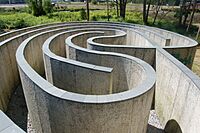
Making Pontevedra more walkable has greatly reduced CO2 emissions from cars. This has been reported by many international TV channels and publications.
How do people get around Pontevedra?
Pontevedra has two main city bus lines. Line 1 connects the Monte Porreiro neighborhood to the train and bus stations. Line 2 connects Monte Porreiro to the Montecelo Hospital. There is also a frequent bus service between Pontevedra and Marín.
The city is well-connected by roads and trains. It is on the railway and motorway that runs from A Coruña to Tui. The Pontevedra bus station has many connections to other cities in Spain and Portugal. The Pontevedra railway station is between Santiago de Compostela and Vigo. There is also a Pontevedra-University railway stop for the university campus. Pontevedra does not have its own airport, but it is close to the airports in Santiago de Compostela and Vigo.
The AVE high-speed train connects Pontevedra to other cities on the "Atlantic Line".
Even though Pontevedra was once a major port, its harbor is now only used for fun, not for cargo ships. The nearby port of Marín is a big military and commercial harbor. The Pontevedra marina is close to the old town.
Landmarks and Sights
Pontevedra is known as a "charming city" with a "definitive old Galician town" feel. It has many religious and civil buildings, plus lovely medieval squares.
Important Religious Buildings
- Baroque church of the Pilgrim Virgin: This is a main symbol of the city. It's on the Place of the Pilgrim Virgin and has a unique rounded, scallop-shaped design.
- Gothic-Renaissance Basilica of St. Mary Major: Built by sailors in the 16th century, it has a beautiful flat facade.

- Gothic church of St. Francis: This church overlooks Herrería Square. It has a Latin cross shape and houses the tomb of Admiral Payo Gómez Chariño.
- Ruins of the Gothic church of St. Dominic: Only the back part with five chapels remains. These ruins are now part of the Pontevedra Museum.
- Baroque church of St. Bartholomew: Built at the end of the 17th century, it has an Italian Baroque style.
- Convent and Romanesque-Gothic church of St. Clare.
- Apparitions Sanctuary: Where the Virgin of Fatima appeared to Sister Mary Lucia.
- Monastery of Saint-Saviour of Lérez: A Baroque monastery with an 18th-century church.
- Our Lady of Placeres church: Built in the late 19th century in Neo-Gothic style.
Important Civil Buildings
- House of the Bells: A Gothic building from the 15th century.
- Counts of Maceda Palace: A Renaissance building from the 16th century, now a Parador hotel.

- Mugartegui Palace: A Baroque palace from the 18th century.
- Pontevedra City Hall: A 19th-century building inspired by Parisian style.
- Palace of the Provincial Council: A 19th-century building.
- Mansion house of the Mendozas: An eclectic mansion from 1880.
- Modern Coffee: An Art Nouveau building from 1902.
- Central Post Office building: An Art Nouveau building from the early 20th century.
- Congress Hall Palace: A modern building from 1997.
- Castelao Building of the Pontevedra Museum: A large, modern building opened in 2013.
Monuments to See
- Monument to the heroes of Puente Sampayo: In the Plaza de España, from the early 20th century.
- Valle-Inclán statue: A statue of a famous writer.
- Tertulia Monument (Literary Circle in Modern Coffee): On St. Joseph's square, showing intellectuals drinking coffee.
- Teucer statue: A statue of the mythical founder of the city.
- Ravachol statue: A statue of a famous parrot.
Famous Bridges
- Medieval Burgo Bridge: From the 12th century, it gave the city its name.
- Tirantes Bridge: A modern cable-stayed bridge from 1995.
- Currents Bridge: A tied-arch bridge opened in 2012.
Charming Medieval Squares
Pontevedra's old town has many beautiful squares. Their names often tell you what used to happen there, like the firewood market or the stone quarry.
- Blacksmith's Square: This is the main square, always busy. It has arches and the Herrería fountain. Blacksmiths used to work here in the 15th century.
- Pilgrim Virgin Square: In the heart of the pedestrian center, it's a main meeting spot. The Church of the Pilgrim Virgin stands here.
- Teucer Square: A perfectly shaped square with orange trees. It's surrounded by grand buildings, like the Gago and Montenegro Palace.
- Firewood Square: This is one of the most picturesque squares in Galicia. It has a calvary (a cross monument) and old houses. Firewood used to be sold here.
- Vegetables Square: This square has old houses and a 19th-century fountain. The House of Light is here, marking where Pontevedra first got electricity.
- Stone Quarry Square: Named for the stonemasons who worked here. It's also called Mugartegui Square because of the Baroque mansion in its center.
- Méndez Núñez Square: In the old town, it has a 15th-century house with a stone coat of arms. A bronze statue of writer Valle-Inclán is here.
- Curros Enríquez Square: A triangular square with a 19th-century fountain.
- Quay Square: Named after the medieval port docks. It has a stone fountain in the center.
- Five Streets Square: Where several streets meet. It has a stone calvary from 1773.
- Plaza Alonso de Fonseca: The Basilica of Santa Maria la Mayor is here.
- Spain Square: Pontevedra's main pedestrian square. It connects the old town to the modern administrative area.
- St. Joseph's Square: Home to the Tertulia Monument, which honors Galician intellectuals. A large sculpture of the Greek hero Teucer statue is also here.
Parks and Green Spaces
Pontevedra has many green areas. It ranks second in Galicia for green space per person.
- Park of the Alameda: Designed by Alejandro Sesmero, surrounded by 19th-century buildings.

- Park of the Palm Trees: In the city center, known for its tall palm trees.
- Park of the Island of Sculptures: On an island in the Lérez river, with sculptures by famous artists.
- Marismas de Alba Natural Park: A large park with paths for walking or cycling.
- Gafos River Park: Borders the Gafos river.
- Seaside promenade – Lérez Banks: Runs along the Ria de Pontevedra and the Lérez River, with paths for walking and cycling.
- Lourizán Park: The most important botanical garden in Galicia.
- Parks and walking areas
Beaches in Pontevedra
The city has three beaches: the Lérez Beach, the Placeres Beach, and the Fontaíña Beach. The Lérez Beach is across from the Island of Sculptures park.
Nearby towns also have many beautiful Blue Flag beaches. These include Portocelo, Mogor, and Aguete. The Castiñeiras Lake is also close by, with picnic areas and playgrounds.
Economy of Pontevedra
Pontevedra has always been a city of trade. In the Middle Ages, different guilds (groups of skilled workers) were very active. In the 16th century, it was Galicia's main port, with lots of fishing and sea trade.
When Spain was divided into provinces in 1833, Pontevedra became a provincial capital. This made it a center for government and business. Today, most people (65%) work in the service sector. About 17% work in industry, mainly in factories and construction. Tourism is growing, with many visitors from Spain and Portugal. The unemployment rate was 7% in June 2021.
What are the main jobs in Pontevedra?
Most people in Pontevedra work in services, like shops, hotels, and offices. This is because the city serves a large area with about 210,000 people. Its location in the Rias Baixas also makes it a popular tourist spot.
Many people work for the government, as Pontevedra is the provincial capital. It has many provincial offices and facilities. The city is also home to many important organizations and institutions.
How important is tourism in Pontevedra?
Pontevedra is the capital of the Rias Baixas tourist region. It is now a leading city in Europe for car-free, walkable urban trips. It's known for its high quality of life, similar to cities like Dubrovnik or Copenhagen.
Tourism has increased a lot in the 21st century. Pontevedra is now a top destination in Galicia and northern Portugal. In 2024, it was even named the most desired city to visit in Spain by Booking.com.
What about trade and industry?
Pontevedra is a major shopping center for its region. It has many traditional shops, national and international stores, and shopping centers. The city is also home to publishing companies like Kalandraka.
Pontevedra has several industrial areas. The O Campiño industrial estate has important industries, including car parts manufacturing. Other companies, like the supermarket chain Froiz, are also based here.
Education in Pontevedra
Pontevedra has a university campus that is part of the University of Vigo. Students can study many subjects here, such as Advertising and Public relations, Fine arts, Nursing, Physiotherapy, and Forest Engineering. It's the only place in Galicia where you can study Fine Arts, Advertising, Public Management, and Design at university level.
The city also has the Higher School for the Conservation and Restoration of Cultural Property in Galicia. Since 1973, Pontevedra has hosted a branch of the national distance university, UNED. The city also has an Official School of Languages where students can learn English, French, German, Italian, Portuguese, and Galician.
Culture in Pontevedra
Museums to Visit
The Pontevedra Museum is one of the top provincial museums in Spain. It includes six buildings:
- The Pazo de Castro Monteagudo.
- The Pazo de García Flórez.
- The former Baroque College of the Society of Jesus.
- The ruins of the San Domingo Convent (Archaeology Museum).
- The Castelao Building, a large modern building opened in 2013.
There is also the Archiepiscopal Towers Interpretation Centre (CITA). This underground museum shows the remains of ancient towers.
Theatres and Concert Halls
Pontevedra has two main cultural venues. The Teatro Principal is in the old town. The Auditorium-Congress Hall is a modern complex for concerts and meetings. There is also the Afundación auditorium.
Libraries and Research
The city has the Pontevedra State Public Library. There are also libraries at the Pontevedra Museum and the university campus.
Other Cultural Activities
The City Council organizes many free public events. These include a Jazz festival, outdoor cinema, and a medieval fair called the Feira Franca. These events often take place in the old town's streets and squares.
The Pontevedra Conservatory of Music was founded in 1863. It is now named after the famous violinist and composer Manuel Quiroga.
Media and Entertainment
Pontevedra has two daily newspapers: the Diario de Pontevedra and Pontevedra Viva (online). It also has a local edition of the main Galician newspaper, La Voz de Galicia.
Spanish and Galician public TV and radio stations broadcast local news. Many national radio stations also have programs in Pontevedra.
Sports in Pontevedra
Pontevedra has a strong sports tradition. Many teams compete professionally:
- Football: Pontevedra CF plays in the Spanish "Segunda División B" at the Pasarón stadium.
- Handball: BM Cisne plays in Spain's top league.
- Rugby: Pontevedra has two rugby teams, Mareantes Rugby Clube Pontevedra and Pontevedra Rugby Club.
- Waterpolo: CN Pontevedra plays in the Galician Waterpolo League.
Pontevedra is home to the Centro Galego de Tecnificación Deportiva (High Performance Sporting Centre of Galicia). It also has many rowing and canoeing clubs. World and Olympic canoeing champion David Cal used to train here.
International Connections
Twin Towns and Sister Cities
Pontevedra is connected with these cities around the world:
 Barcelos, Portugal
Barcelos, Portugal Merlo, Argentina
Merlo, Argentina Nafpaktos, Greece
Nafpaktos, Greece Salvador da Bahia, Brazil
Salvador da Bahia, Brazil San José, Costa Rica
San José, Costa Rica Santo Domingo, Dominican Republic
Santo Domingo, Dominican Republic Vila Nova de Cerveira, Portugal
Vila Nova de Cerveira, Portugal
Famous People from Pontevedra
- Enrique MacDonell: A Vice Admiral in the Spanish Navy.
- Paio Gomes Charinho (1225–1295): A poet and troubadour.
- Benito de Soto (1805–1830): A famous pirate, known as the "Last Pirate of the Atlantic Ocean."
- Xoán Manuel Pintos Villar (1811–1876): A writer who published the first book in modern Galician.
- A.D.R. Castelao (1886–1950): A very important Galician writer, artist, and politician.
- Manuel Quiroga (1892–1961): A famous violinist, composer, and artist.
- Alejandro de la Sota (1913–1996): A well-known architect.
- Mariano Rajoy (1955–): A former Prime Minister of Spain.
- Francisco Javier Gómez Noya (1983–): A triathlete and World Champion.
- Pablo Cimadevila Alvarez (1978–): A Paralympic Gold Medalist and jeweler.
- Teresa Abelleira (2000-): A football player.
Images for kids
See also
 In Spanish: Pontevedra para niños
In Spanish: Pontevedra para niños


